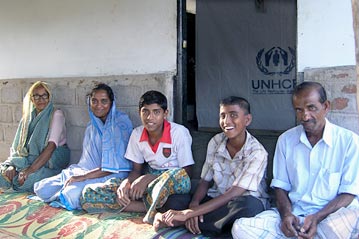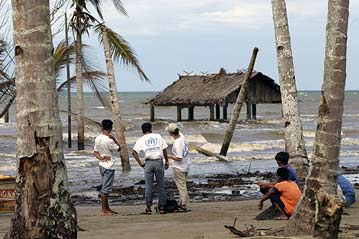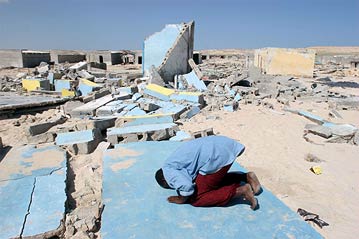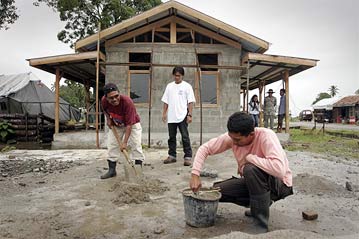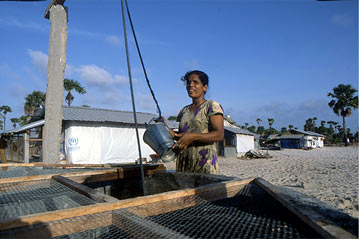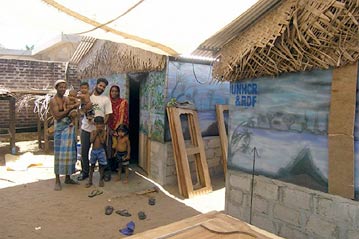UNHCR completes its post-tsunami shelter commitments in Sri Lanka
UNHCR completes its post-tsunami shelter commitments in Sri Lanka
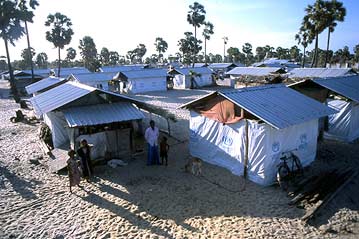
GENEVA, December 21 (UNHCR) - In the immediate aftermath of last December's devastating tsunami, providing transitional shelter for the hundreds of thousands of people who had seen their homes dashed to pieces seemed a daunting task. But the UN refugee agency and its partners have overcome many obstacles to deliver all the shelters they had promised well before the first anniversary of the disaster.
"When I went out there it was the middle of February and the situation on the ground was fairly chaotic," remembers UNHCR's senior shelter coordinator Jo da Silva, who was sent to Sri Lanka to oversee the agency's post-tsunami shelter role.
"The initial emergency relief had been very successful in that no people died post-tsunami. But there was a very, very large number of agencies - I mean an incredible number of agencies on the ground, and an awful lot of money," she said back in Geneva after her mission ended in October.
Tents, however vital they were in the short-term for emergency shelter, were only a temporary solution to Sri Lanka's massive housing problem. But rebuilding was going to take a long time. Roughly 100,000 houses were lost in the tsunami, and in normal times only 5,000 houses a year are constructed in Sri Lanka.
"The mismatch between the amount that was lost and the capacity of the country to rebuild was huge.... Despite however much foreign aid comes in, however much local capacity-building happens, that's a very big gap," said da Silva, a civil and construction engineer.
Transitional shelters were essential to get the homeless people out of the temporary tents and school buildings where they were first placed, and to provide a solid roof over their head until permanent shelter could be built.
But the scale of the operation was enormous, with 500,000 homeless people scattered along nearly 1,000 km of coastline, more than 100 organizations keen to build transitional shelters, and a great deal of cultural, political and ethnic diversity to contend with.
"The result of all of those things meant that shelter coordination was extremely complex and challenging," said da Silva. "But, nevertheless, we managed to develop the strategy, issue standards and guidelines, so that six months later 55 shelters had been built," she said.
By mid-September, nine months after the gigantic waves smashed homes to bits, only 2,000 families were still left in emergency accommodation throughout the country. Transitional shelter had been identified for them and was being built.
For UNHCR, coordinating the shelter sector was a huge task.
"We were coordinating 55,000 shelters. Of that UNHCR was responsible for 2,882 shelters in Ampara and 1,558 in Jaffna, which adds up to 4,400, representing approximately 7 percent of the total need, making us in the top five providers in terms of numbers," da Silva added. In all, the UNHCR shelters are accommodating approximately 22,000 people whose houses were damaged or destroyed.
UNHCR's transitional shelters are designed for a family of five. They measure 12 x 16 feet (3.7 x 4.9 metres) and consist of two rooms, built within a galvanized iron frame. Brick foundations provide a strong and solid base for the plywood walls and the zinc-aluminium roof. Although more expensive than tin, zinc aluminium is also more heat-resistant - an important factor in a hot climate.
"I think the really important thing is that the quality of UNHCR shelters has been widely acknowledged, and that's very apparent on the ground because you can see so visibly the way that the beneficiaries have taken ownership of their shelters and even painted them bright colours and added porches," da Silva said.
The people now living in their new transitional homes seem genuinely happy.
"So even now there are people who have received shelters from other organizations who are coming and asking for a UNHCR shelter," she said, noting that some sub-standard shelters were erected and will leak during the heavy monsoon rains.
"You don't get perfection in a post-disaster situation. And I think the other thing that people don't understand is what I call non-linear management. People like to think of management processes as linear things, you plan and you execute the plan. But with post-disaster situations, you are responding - and it has to be very reactive," da Silva added.
The transitional shelters are just an interim measure until permanent shelters can be built. This next phase will be carried out by NGOs and other organizations that have signed agreements with the Sri Lankan government to construct permanent housing. On the UN side, overall responsibility has been handed over to the UN Office for the Coordination of Humanitarian Affairs.
"To me transitional sheltering comes under protection. It's just looking after people in that interim period when they are displaced.... Transitional shelter is the catalyst to enable families to re-establish their normal household routine and start rebuilding their livelihood," da Silva said.
As the anniversary of the tsunami refocuses attention on Sri Lanka's shelter programme, da Silva said she anticipates some criticism. There will inevitably be problems with some of the houses. But she believes only a very small proportion of the shelters - somewhere between two and five percent - will be affected.
"The important thing is to remember the scale of the problem and the fact that half a million people were affected and all of those people are in a much better situation than they were six months ago," she said.


